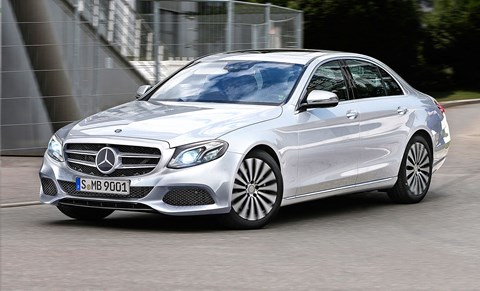► 2016’s most wanted cars, #3 and #2 on our list
► New Mercedes E-class and BMW 5-series
► Teched-up geeks, but is there room for a driver?
Business class gets upgraded to first in 2016 as BMW and Mercedes load their Mk7 5-series/E-class rivals with the sort of kit and tech you used to expect only on a limo. That means not just more luxury, but cutting edge powertrains, futuristic driver aids, ultra-light materials and platforms so smart they make Stephen Hawking look like Joey Essex.
Merc’s modular rear-wheel-drive architecture (MRA) and BMW’s cluster platform (CLAR) are both flexible and scalable, so you’ll find them underpinning everything from C-class to Maybach (not the crossovers though) and from 2-series to 7, with X-models included. Both use aluminium, and BMW also incorporates carbonfibre reinforcement elements, to elicit weight savings of between 70 and 150kg.
Better packaging frees up more space too.
A big, fuel-saving breakthrough comes from 48-volt electrical systems. Not only do they feed ancillaries such as oil and water pumps (goodbye to belt-drive!), but the system is also much better at recuperating brake energy and storing it in a lithium-ion battery. 48v also provides the power for new gadgets, such as electrically operated turbos delivering instant boost. Other future tech it could facilitate includes semi-active suspension with dynamic anti-roll/dive/squat, and electric actuators in lieu of springs and shocks. Radar surface scanners will replace camera-based sensors (which don’t work at night).
Plug-in hybrids will be more prevalent in each line-up. Uncannily, both brands will offer 2.0-litre engines mated to 82bhp e-motors; Merc will also offer a six with 109bhp e-assistance in the US, and a plug-in diesel for Europe. And Mercedes is junking its V6s in favour of new, cheaper-to-build in-line sixes too. Out first is the 2.9-litre diesel with 313bhp in twin-turbo guise and over 400bhp when motivated by four chargers, two of them battery-driven. At the bottom end of the range, there’s a new 122bhp 1.6-litre four which, like BMW’s 520d, is aiming for 99g/km of CO2.
Driver tech systems will personify both cars. Made by the same hardware supplier they’re unsurprisingly similar, featuring remote-control manoeuvring, predictive driving governed by sat-nav, different levels of touchscreen interaction and gesture control, lane-changing and overtaking assist, and an autobahn-assistant which can be left alone at up to 80mph.
Still room for the driver in all this? We hope so.

The chassis
Both cars are based on modular lightweight platforms that will serve everything from C-class to Maybach, from 2-series to X7. 48v electrics means greater efficiency and more gadgets: semi-active suspension and virtual dampers coming in the future!
The power trains
E-class and 5-series will go plug-in hybrid, both using 2.0-litre 4-cyl engines with 82bhp e-motors. Merc is ditching V6 engines for inline sixes, and both cars will get downsized four-pot diesels in a bid to crack 99g/km CO2.
The technologies
Both cars will feature spookily similar, hugely complex driver assistance systems, with remote-control parking, car-to-car comms, gesture control and sat-nav controlled predictive driving. They disagree on lights though: BM favours lasers, Merc LEDs.
The line-ups
Four-door saloons will remain the best-sellers, but Europe will gobble up the 5-series Touring and a much better-packaged 5GT. China’s fondness for limos will mean lwb versions will be key, with BMW basing its new e-power model on the lwb 5-series. New E-class coupe and cabrio will become proper four-seaters.